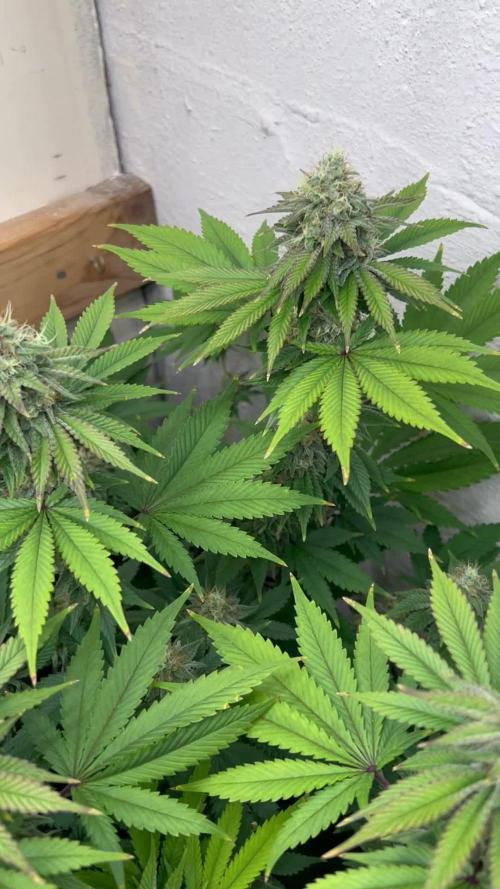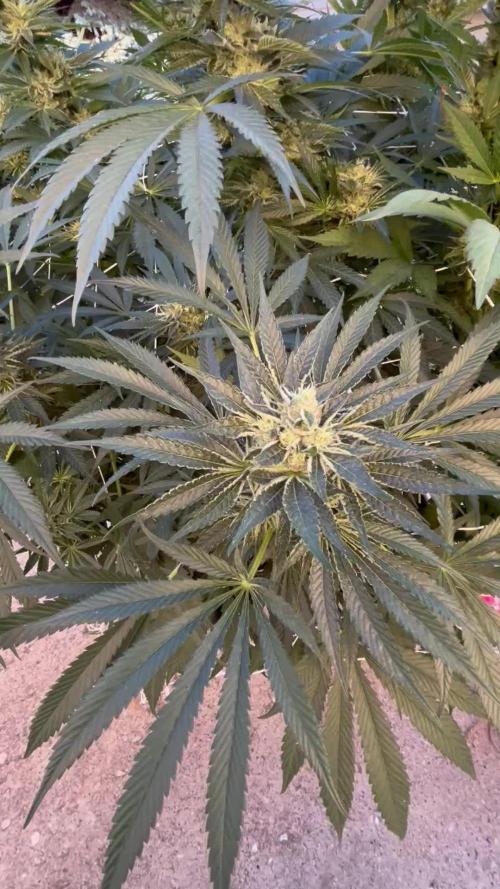The Grow Awards 2026 🏆 



































Likes
Comments
Share


@Kitties_and_Colas
Follow
My suspicions of some kind of infection with the plant on the right was confirmed this week and I learned a new word "fasciation"...it's all over the internet but i've never heard of this before now...the plant continues to look worse and worse no matter what i do, a few of the older clones are starting to do the same thing so i threw them all out...The plant on the left looks on track with maybe 2 1/2 weeks to go..
Likes
19
Share


@GoldenWeedGrower
Follow
Legend
Timestamp: 📅
EC - pH: ⚗️
Temp - Hum: 🌡️
Water: 🌊
Food: 🍗
pH Correction: 💧
Actions: 💼
Thoughts: 🧠
Events: 🚀
Media: 🎬
D: DAY, G: GERMINATION, V: VEGETATIVE, B: BLOOMING, R: RIPENING, D: DRYING, C: CURING
________________________________
📅 D105/R01 - 28/02/24
⚗️ EC: 0.9 pH: 5.2
🌡️ T: 21-25 °C H: 50-65 %
🌊
🍗
💧
💼
🧠 Ripening starts
🚀
🎬 Added timelapse and screenshots and monthly rate of T-H and VPD 📈📈📈 from TrolMaster App
Translate
________________________________
📅 D106/R02 - 29/02/24
⚗️ EC: 1.2 pH: 6.7
🌡️ T:21-24 °C H: 50-65 %
🌊
🍗
💧 Added pH+
💼
🧠 If someone who followed the diary from the beginning is asking himself what about mother plant "Mamma Aglio", here I posted some picture of her which demonstrate the difference between a bad and a good grow
🚀
🎬 Added pics of Nicole and pics of "Mamma Aglio" to show the difference between a bad and a good grow with sounds and TrolMaster logo. Added usual timelapse and screenshots.
________________________________
📅 D107/R03 - 01/03/24
⚗️ EC: 0.8 pH: 6.4
🌡️ T: 20-24 °C H: 45-65 %
🌊 2L
🍗
💧
💼
🧠
🚀
🎬 Added Timelapse and screenshots. 4 pics added
________________________________
📅 D108/R04 - 02/03/24
⚗️ EC: 0.8 pH: 6.7
🌡️ T: 20-25 °C H: 45-70 %
🌊 1L
🍗
💧
💼
🧠
🚀
🎬 Added Timelapse
________________________________
📅 D109/R05 - 03/03/24
⚗️ EC: 0.8 pH: 6.7
🌡️ T: 21-25 °C H: 45-65%
🌊 RES Changed 💦💦💦
🍗
💧
💼
🧠 I'm starting the flush, as trichomes look milky and quite ready. In this last week the ripening will be complete and th girl would be ready for harvesting.
🚀 Flush started
🎬Added 8 pics of trichomes, Timelapse and sceenshots. Two pics and two videos of my "garden's pre-harvest magic" 😋😋😋
________________________________
📅 D110/R06 - 04/03/24
⚗️ EC: 0.2 pH: 7.5
🌡️ T: 19-25 °C H: 55-65%
🌊
🍗 Flawless finish
💧
💼
🧠 1 day with pure water and now I added Flawless finish
🚀 Flushing
🎬Added Timelapse and sceenshots
________________________________
📅 D111/R07 - 05/03/24
⚗️ EC: 0.2 pH: 7.5
🌡️ T: 20-25 °C H: 55-65%
🌊
🍗
💧
💼
🧠
🚀 Flushing
🎬Added 8 pics. Added timelapse and screenshots. I also prepared a timelapse of the entire week with some music 🎵🎵🎵 and weekly rate of T-H and VPD 📈📈📈
Likes
10
Share


@Pechu420
Follow
The best plant I have ever grown. Very resistant, and great flowering, fat buds, large flowers and beautiful colors on top of a whitish resin. This week there is no fertilizer, so as not to have problems with the harvest regarding taste. The leaves turn yellow quickly.
Likes
8
Share


@Bryankush
Follow
Il fumo è liscio e abbastanza dolce e fruttato con aromi che ricordano uno sherbet di arancia, anche piuttosto denso.
Likes
1
Share


@ScutFarkus420
Follow
Day 42 of 12/12 Smells amazing!! Buds are fatting up nicely and are frosty af!!
Processing
Likes
9
Share


@LittleBigTrees
Follow
Put some into bigger pots, 2 are autos for sure.
Still no idea what the others are though from the leaves on two I think they may be lemon kush but I'm really not sure.
Likes
16
Share


@eldruida_lamota
Follow
Vamos familia hora de cortar estás Blueberry Cheese de ZambezaSeeds, ya tenia ganas.
La verdad que el secado muy bien 7 días en Malla y a los botes, 40% humedad y 24 grados es la temperatura ambiental que han tenido en el secado.
Por lo demás de miedo os la recomiendo.
Gracias a Agrobeta y Mars hydro , sin ellos este proyecto no sería igual 🙏.
Agrobeta:
https://www.agrobeta.com/agrobetatiendaonline/36-abonos-canamo
Mars hydro:
Code discount: EL420
https://www.mars-hydro.com/
Buenos humos.
Likes
60
Share


@Chucky324
Follow
Hello. This is the last pictures of the growing Sweet Zenzation. I'll be cutting them down after a couple of days of dark.
I'm pleased with the way this plant grew. Big dense buds and the stock was strong enough to hold up the big buds. The buds have a darker color sort of purplish to them.
The smell is pleasant, sweet and candyish. I wonder which fruit'z these Zkittlez tastes like?? : )
I'll cut some taster buds and let them dry while the buds are curing and be ready to make a smoke report when I come back with the harvest report.
See ya in a couple of weeks. Chuck.
Likes
9
Share


@DaddyPrime2
Follow
11/03/24
need to get them into a bigger tent. running out of vertical space.
11/07
not sure if i should top them and try to keep them short or figure out how to get them into the flower
11/09 transplanted #2 into a 3 gal fab pot.
#5 had to be topped at every main to keep her
Likes
16
Share


@Northern_Ent
Follow
Sep 13: nearing the finish line. Doing a chemical flush this year cuz my buds lasy year often didn’t burn very well due to too much P. Using Final Flush from Grotek which uses citric acid as a chelating agent. Other flushes like Flawless Finish use EDTA which I’d rather avoid.
Sep 15: removed fan leaves that were shading buds.
Likes
20
Share


@NONSENSE
Follow
Week2:
The plants looks very nice. x 3 are ROYAL Cookies
And the two babies are Afghan regular and Diesel fem.
The middle Cookies plant is bigger= 2 days older then other ones. You can see the difference.
From tomorrow I will start to train the plants. I will LST two small plants.
The bigger one will be topped also.
The genetic is very good. There are a lot of colas and they are located close.
I hope to have time to develop about 8 colas for each plant.
Less than three months are left until the end of the RQS cup.
So from January 1, I plan to start flowering.
The plants eat and drink good. i see small iron deficiency( the leaves are a little bit yellow.) i will Flush the plant with pure 6.0pH water and microelements only. Flushing should remove nutrient salt build-up
Likes
1
Share


@Sur_cannabico
Follow
Su alimentación basada en la línea completa de Quemanta Nutrientes, nos otorgó grandísimos resutados, cosechando la primera planta con 80% de sus tricomas tonos lechosos.
Likes
2
Share


@xTaps
Follow
Just checking the trichome heads daily to harvest them at the for me perfect moment.
Likes
5
Share


@coihue_ancestral
Follow
Hasta el momento todo ha ido bien, el proceso de crecimiento se ha notado acelerando aumentando las horas de exposición a la luz solar🤝
Likes
422
Share


@Crashoverite
Follow
Hi all,
Welcome to my 🍌💜👊 week update.
Thank you so much for your all support on this bananas journey 💜💚💜💚
Week 12
Jan 1 - Jan 7
I am so happy seeing how my girls are developing. All it's going great. 2 waterings of 8ltr on 03/01 no runoff and second on 06/01 9.5ltr! Runoffs PH at 6.2. Purchased larger dehumidifier and installed on 03/01 instantly humidity decreaseed from 55-59 to 50-55 on avg. and at night from 62-69 to 54-60. Light from 01/01 on max power output 110 watts. Nutes slightly adjusted. Buds on both girls gaining size, weight. Trichomes on Athena mostly milky and clear with only very few ambers. Xena mostly 50/50 clear and milky,
They are smelling gorgeously, not sure if I should smoke or eat them first.
Next week will still feed with nutes and keep an eye on trichomes development but it seems that girls are not in a hurry at all. That's okay me neither 😁
Stay tuned for next week entry very soon!
Peace and love brothers and sisters ✌️💚
Links
https://2fast4buds.com/seeds/banana-purple-punch-auto
https://plagron.com
https://www.biobizz.com/
https://fishheadfarms.com/
Likes
12
Share


@WulfBlud
Follow
Removed all lower fan leaves and fan leaves from bud sites to maximize yield. Hoping it wasn’t too late for this but seems to have reacted positively.
Likes
20
Share


@eldruida_lamota
Follow
Variedad con una floración corta, entre 8/9 semanas.
Procedente del original Exodus Clon (UK).
Predominancia indica con un nivel de thc superior al 16% .
Es muy fácil de cultivar y la alimentación la acepta muy bien en general .
Cada etapa cumplió con mis expectativas y por ello aparte del sabor el colocon ... en cuanto a todas sus etapas le doy 9/10 .
CEPA BRUTAL enserio.
Likes
92
Share


@Roberts
Follow
Well finally got a seed germinated. This batch was pulled for quality control. At least I got 1 plant. Hopefully she does well. She has a late start compared to others. I will be using a Spider Farmer SE5000, and a New Level Hydro 5 gallon bucket system links below. Thank you Spider Farmer, New Level Hydro, the Amsterdam Marijuana Seeds. 🤜🤛🌱🌱🌱
SE5000
https://amzn.to/3qFpAML
Spider Farmer Official Website Links:
US&Worldwide: https://www.spider-farmer.com
UK: https://spiderfarmer.co.uk
CA: https://spiderfarmer.ca
EU: https://spiderfarmer.eu
AU: https://spiderfarmer.com.au
Coupon Code: saveurcash
Thank you grow diaries community for the 👇likes👇, follows, comments, and subscriptions on my YouTube channel👇. ❄️🌱🍻 Happy Growing 🌱🌱🌱
https://youtube.com/channel/UCAhN7yRzWLpcaRHhMIQ7X4g
www.newlevelhydro.com
www.hygrozyme.com























